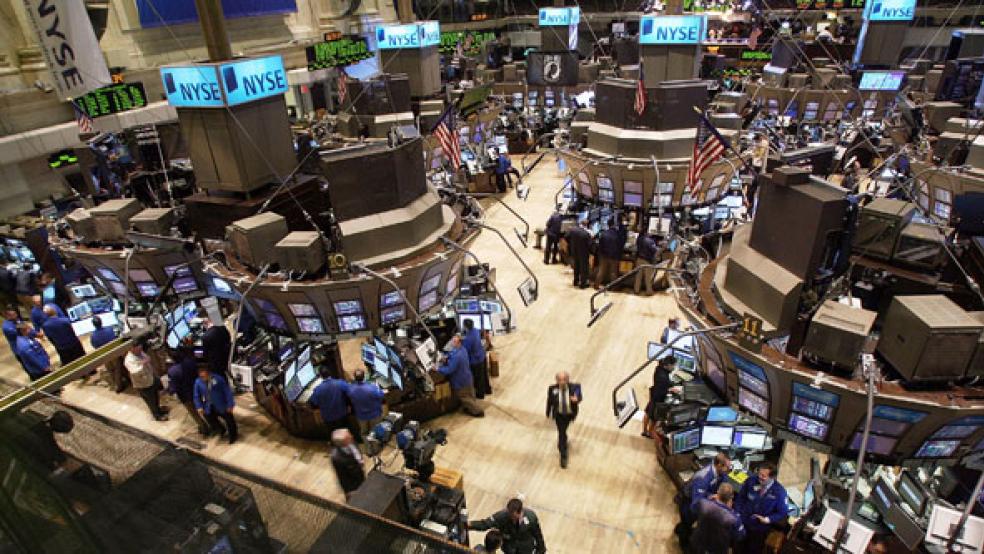The streak is over, but is the trend intact?
A six-week string of gains in the S&P 500 ended on Friday amid shifting expectations for central bank stimulus. This week could bring clarity on that issue, and that could determine whether the recent rally that took the index to four-year highs will persist.

"The streak is broken, but the trend isn't, and I think the next major move on the S&P will push us up towards 1,450 or 1,500," said Mark Arbeter, chief technical strategist for Standard & Poor's in New York. "Small- and mid-cap stocks are near their all-time highs, and if they break those highs, I think that will prompt the market to really rip higher."
Still, the market could be in for a bumpy ride this week ahead of Friday's meeting of central bankers in Jackson Hole, Wyoming, Investors are looking for clues on whether Federal Reserve Chairman Ben Bernanke will announce a third round of quantitative easing.
RELATED: Fed Considers New Push for Ailing Economy: QE3
Bets on aggressive action to increase growth have spurred most of the market's recent gains, meaning any disappointment could stop the rally in its tracks. The CBOE Volatility index or VIX <.VIX>, a measure of investor anxiety, jumped almost 13 percent last week.
While many analysts expect QE3 - and Bernanke wrote a letter to a congressional panel that the Fed has room to deliver it - the odds seemed to decline following comments on Thursday from James Bullard, a non-voting member of the Federal Open Market Committee. He said the latest Fed minutes, which indicated the central bank might be ready for more stimulus, were "stale."
"Rhetoric is going back and forth about what we can expect, and we could see some big gyrations going into the meeting, depending on the latest rumor," said Michael Matousek, a senior trader at U.S. Global Investors Inc in San Antonio.
IS QE3 BAKED INTO THE CAKE?
In the recent six-week winning streak, the S&P's longest since January 2011, the index climbed 4.7 percent. That could indicate QE3 has already been priced into shares. "I think we're priced so that we won't see a major move if something is announced," Matousek said. "But if the status quo persists, which is what I'm expecting, that could be a big disappointment."
Daily trading volume, which has been among the lowest of the year recently, is expected to remain muted ahead of the meeting. Low volume could amplify stock swings in both directions, and there is little other news to otherwise drive trading. Following the Jackson Hole meeting, there will be a market holiday on September 3 for Labor Day. Trading is expected to pick up after that, with a major catalyst seen on September 6, when the European Central Bank has its next meeting.
The ECB recently pledged to "do whatever it takes" to address the euro zone's debt crisis, comments that contributed to recent positive sentiment.
Earnings season is winding down, with only five S&P 500 components scheduled to report in the coming week, including Tiffany & Co <TIF.N>, Joy Global Inc <JOY.N> and H.J. Heinz <HNZ.N>.
With 98 percent of S&P 500 companies having reported results, 67 percent have topped expectations by an average surprise factor of 4.3 percent, according to Thomson Reuters data. The 67 percent beat rate is higher than the long-term average of 62 percent. However, there have been some notable disappointments lately, including Hewlett-Packard Co <HPQ.N>.
Economic indicators includes August reads on consumer confidence and sentiment, the latest read on Chicago PMI and July pending home sales. The Fed's Beige Book, a collection of anecdotal information on current economic conditions, will also be released.
"The market is torn between macroeconomic concerns on one hand, and relatively good earnings and business trends on the other," said John Carey, who helps oversee $260 billion as a portfolio manager at Pioneer Investment Management in Boston.
"I'm encouraged by the fundamentals out there, but unquestionably, the economy has slowed."
The S&P 500 fell 0.5 percent last week, a relatively mild decline after six weeks of gains. On Tuesday, it surged to its highest level since June 2008 before pulling back. The Dow Jones industrial average <.DJI> slid 0.9 percent for the week, while the Nasdaq <.IXIC> slipped 0.2 percent.
For the year, all three major U.S. stock indexes have racked up substantial gains. The Dow has gained 7.70 percent for 2012 so far, while the S&P 500 had advanced 12.21 percent and the Nasdaq has climbed 17.84 percent.
"The market has been so strong lately that there's the idea Bernanke could pull back from QE3 as a result of that," said Randy Frederick, managing director of active trading at Charles Schwab in Austin, TX. "But then, all that really means is that the market is able to stand on its own two feet."




